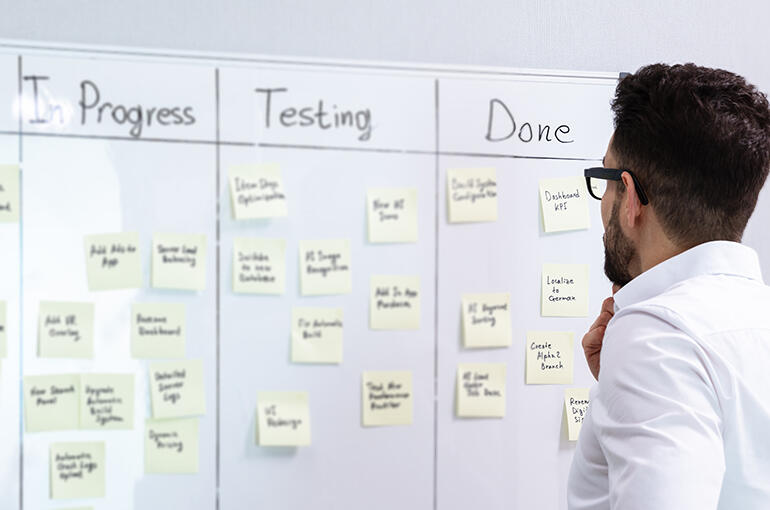
Jennifer
Nusbaum
Vice President, Americas Agile Coach

The rate of change is accelerating across our business and in industries that impact our business. What has made us successful in the past is not going to be sufficient for us to thrive into the future. The advances we see in computing power, digital data, artificial intelligence, genomics, consumer engagement approaches and precision medicine are staggering, and this is just the beginning. Innovation is driving transformational change and forcing us to reimagine the future of life insurance underwriting, what we call Underwriting Reimagined®.
The pace of digitization continues to accelerate, and COVID-19 has added significant urgency well beyond what anyone might have predicted at the start of 2020. The increased use of digital platforms has changed how customers interact with business, and companies must evolve to serve those customers well.
How quickly an organization can adapt and thrive in this dynamic environment will play a large part in determining its relevancy going forward. By nature, agile organizations are well suited to manage market shifts into opportunity for innovation and a source of competitive advantage. At SCOR, we believe that our ability to react and capitalize on these shifts is a key factor in determining our future success.
In today’s environment no industry is immune from disruption. To the contrary, the current pandemic has proven rapid change is indeed needed -- and is possible. Companies have found more effective ways to work, exploring innovation and embracing test-and-learn philosophies. An agile organization encourages employees to take active roles in cultivating and sustaining meaningful change and in learning and sharing knowledge.
According to The Age of Agile by Stephen Denning1, ensuring that the workforce is engaged is an important tool for achieving organizational agility. Across US industries, only one in five employees report that they are fully engaged in the work and about 14% are actively disengaged, “intent on deliberately undermining what the organization does.”
A 2017 Gallup poll2 showed that being able to move from 30% of employees strongly believing that their opinions count at work to 60% could mean a 27% reduction in turnover – and a 12% productivity increase.
Eliminating silos and creating cross-functional teams within the organization that better align people who have the necessary expertise and skillsets are fundamental to success. Business processes must be optimized to eliminate unnecessary gatekeepers and redundancy. Clearly defined roles and accountability for results help ensure stability is balanced with agility.
Partnerships for shared value present a huge opportunity to increase capabilities. These partnerships cover a broad range and include insurers, reinsurers, data aggregators and distributors supported by marketing, analytics and health and wellness companies that will help accelerate our response to a shifting landscape.
Achieving organizational agility as an industry will require that we overcome the barriers including our regulatory environment. The process for filing applications in multiple jurisdictions limits the industry’s ability to test and learn quickly. The differing views on genetics and use in underwriting must be resolved
A 2019 Transformation GPS study by Accenture found that agile companies see a 16% growth in earnings within 10 years, which is 10% higher than the average. Those businesses are more than twice as likely as the average organization to achieve top-quartile financial performance (55% vs. 25%).3
For the Life insurance industry to thrive into the future, we must revitalize our traditional business models to anticipate and respond to the changes in market conditions and customer needs. What has made us successful in the past is not going to be sufficient.
The introduction of new consumer technology continues to accelerate across many industries. We see significant advances in the biomedical space, precision medicine/health, next generation pharmaceutical and wearable devices that monitor and collect an ever-expanding universe of information. These developments will enable consumers to take a more proactive view on longevity and health span using Life insurance to help achieve these goals – but based on their individual needs. Our ability as a Life insurance industry to react and provide focus to these changes will be a key factor to our relevance into the future.
The distribution approach that has supported our industry for many years will struggle to connect unless Life companies explore how to engage customers in new ways via digital platforms, with new offerings for unique risks and a smoother overall customer journey. Companies who do not evolve will be overlooked by newer generations looking for personalized on-demand services and efficient transactions.
As one example, disruption of traditional fluid-based underwriting protocols during the pandemic have pushed Electronic Health Records (EHR) into prominence. The conversation is no longer about whether EHR will replace Attending Physicians Statements but about how quickly will it happen.
The rise in OCR technology, artificial intelligence and machine learning that allow underwriting systems to talk to administration systems create opportunities for Life carriers to expand analysis. Companies who accept technology challenges using test-and-learn processes and partnerships to advance such capabilities evolve faster, becoming more agile and better prepared to capitalize on post-pandemic volatility.
We are already seeing industry-supporting technology firms that have stepped in to embrace change and fill the gaps between what consumers want and what traditional players provide. These firms are more agile than most Life companies because they do not face the constraints of legacy systems, ultimate risk bearing or large organizational hierarchy. They focus on their core competencies.
Life companies can partner with these firms or be replaced by them, as they become more willing to participate in risk and design entirely new systems to capitalize on digital information. Life companies will either disrupt themselves or see disruption at the hands of these new technology providers.
So far, we have been able to navigate COVID-19-related changes and clear the first wave of customer engagement hurdles. But our adaptive capacity must continue to expand as we face and absorb further downstream effects. All of this change places significant stress on organizations to modify thinking and adapt behaviors.
Setting flexible goals means we can adjust our priorities based on what we are learning, the opportunities that we discover and the needs of our customers. Consider the market conditions pre-pandemic, during pandemic and the future post-pandemic. Are our goals agile enough to flex to the rollercoaster that is 2020 and beyond?
We must move away from long-standing industry conventions. The pandemic has given us an opportunity to see change as the disruptor that forces us to do things differently. Market conditions changed, customer behaviors adjusted in response to those, and new opportunities arose. Organizational agility is the ability to quickly and effectively assess whatever emerges and partner with solution providers to leverage changes and deliver products that bring value to our customers.
Fundamental to Life insurance being relevant in the future is our ability to react and evolve with change. Innovation is driving transformational change, and reinsurers are in a unique position to move the industry forward more quickly. Contact your account executive or me to discuss how we see the future of life insurance underwriting – Underwriting Reimagined!
CONTACT
OUR EXPERTS

Jennifer
Nusbaum
Vice President, Americas Agile Coach

Bruce
Miller
Vice President, Head of Knowledge Agility